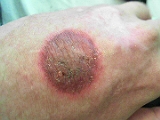Aerosol burn
| aerosol frostbite of the skin | |
|---|---|
| Other names | Aerosol-induced frostbite |
 | |
| Aerosol frostbite to the hand | |
| Specialty | Emergency medicine |
An aerosol frostbite of the skin is an injury to the body caused by the pressurized gas within an
The form of injury is freezing of the skin, a type of frostbite. It is highly advised for those who develop frostbite to seek medical attention.[4]
In rare cases aerosol-induced burns can be severe enough to necessitate
Signs and symptoms

Depending on the duration of exposure aerosol-induced frostbite can vary in depth. Most injuries of this type only affect the
Causes
The most common cause of aerosol burns is patients' spraying deodorants for prolonged periods of time in close proximity to their skin. This practice is more common in younger persons such as teenagers and can be referred to as "frosting" or having a "frosty". Injuries such as these are often
However, some do it due to influence by their peers as a way of "impressing" them, with the "Aerosol Challenge" gaining popularity alongside the "
Unintentional
A person can cause frostbite by accidental prolonged contact, using an aerosol on one place for too long.
Intentional and abuse
Some aerosol burns are intentionally self-inflicted, the reasons being emotional/psychological. Household aerosol products such as air fresheners and deodorants can be a convenient, easily available means to satisfy the compulsions.[18]
Treatment
Various methods of treatment are used, depending greatly on the length of exposure and other factors. There are documented cases using both conservative and invasive treatments, including skin grafting and/or the application of nonadhesive dressing alongside
In the case of self-harm induced injury the underlying mental health aspects should be treated as with all self-inflicted injuries.
See also
- List of cutaneous conditions
- Deodorant
- Aerosol spray
- Freeze spray
- Frostbite
- Burn
References
- ^ "Brrrr! Aerosol sprays are a silly way to get frostbite - The Body Odd". Bodyodd.msnbc.msn.com. Archived from the original on 2012-05-07. Retrieved 2012-07-01.
- ^ from the original on 2015-06-27. Retrieved 2012-07-01.
- ^ "Deodorant burns on the increase - ABC News (Australian Broadcasting Corporation)". Abc.net.au. 2007-07-10. Archived from the original on 2020-01-11. Retrieved 2012-07-01.
- ^ "Login | Electrolube - the Solutions People" (PDF). Archived (PDF) from the original on 2015-04-02. Retrieved 2015-03-11.
- ^ S2CID 900852.
- ^ "Frostbite: Complications". MayoClinic. Archived from the original on 2012-12-26. Retrieved 2012-07-05.
- ^ "Frostbite: Symptoms". nlm.nih.gov. Archived from the original on 2016-07-05. Retrieved 2012-07-05.
- S2CID 3701270.
- ^ Miller, Ryan W. (May 9, 2018). "'Deodorant challenge': Are teens really burning their arms to go viral?". USA TODAY. Archived from the original on January 11, 2021. Retrieved 2021-01-11.
- ^ Knudson, Annalise (2018-04-03). "Social media challenges: 8 dangerous teen trends". silive. Archived from the original on January 11, 2021. Retrieved 2021-01-11.
- PMID 21209810.
- PMID 22174972.
- PMID 9677032.)
{{cite journal}}: CS1 maint: numeric names: authors list (link - PMID 10630273.
- ^ "Inhalants". Archived from the original on 2013-01-19. Retrieved 2012-11-01.
- ^ "Inhalant Abuse is on the Rise". www.kidsgrowth.com. Archived from the original on 2016-07-01. Retrieved 2012-11-01.
- ^ "Inhalant Abuse by Children". Archived from the original on 2016-11-14. Retrieved 2012-11-01.
- S2CID 7265071.
- ^ "About Cancer". 2017-08-30. Archived from the original on 2011-07-14. Retrieved 2012-10-28.
